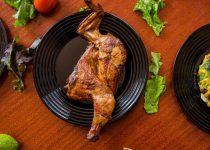When Is Rotisserie Chicken Done Cooking
So, you've just picked up a mouthwatering rotisserie chicken from the store, but now comes the million-dollar question: When is it done cooking?
We've all been there, anxiously eyeing that golden-brown bird, wondering if it's fully cooked and safe to eat.
But fear not, because in the next few minutes, you'll learn the foolproof ways to determine if your rotisserie chicken is perfectly done and ready to be devoured.
Get ready to make sure your next meal is not just delicious, but also safe to eat.
Understanding Safe Internal Temperatures
Do you know what the safe internal temperatures are for cooking rotisserie chicken to perfection?
Safe handling of chicken is crucial to avoid foodborne illnesses. The recommended safe internal temperature for cooking rotisserie chicken is 165°F (73.9°C). This ensures that any harmful bacteria present in the chicken are destroyed, making it safe to eat. When checking the temperature, it's important to insert a meat thermometer into the thickest part of the chicken, avoiding contact with bones.
Cooking time is also a key factor. The cooking time for rotisserie chicken can vary depending on the size and weight of the bird. Generally, it takes about 15-20 minutes per pound of chicken at a cooking temperature of 350°F (175°C). It's important to monitor the cooking process closely, using a meat thermometer to check the internal temperature as it nears completion.
Checking for Clear Juices
To check for clear juices, carefully pierce the thickest part of the chicken with a knife or fork, and observe the color of the juices that run out. When checking for clear juices in rotisserie chicken, it's essential to understand what visual cues to look for. Here's how you can master the juiciness test:
- Clear and Transparent: Clear juices indicate that the chicken is fully cooked. When the juices run clear, it's a sign that the chicken has reached the right level of doneness.
- No Pink Tinge: If the juices have a pink or red tinge, it's a sign that the chicken needs more time to cook. This visual cue is crucial in ensuring the chicken is safe to eat.
- Moisture Content: The appearance of the juices also provides insight into the moisture content of the chicken. Clear juices indicate a well-cooked and juicy chicken, while cloudy or bloody juices suggest that the chicken needs more time to cook.
- Texture: In addition to color, the texture of the juices should be observed. Clear juices with a slightly thick consistency are a good indicator of perfectly cooked rotisserie chicken.
Mastering the art of checking for clear juices will elevate your cooking skills and ensure that you serve perfectly cooked rotisserie chicken every time.
Examining the Color of the Meat
When you're cooking a rotisserie chicken, the color of the meat can tell you a lot about its doneness.
Pay attention to the meat color indicators – pinkness could mean it's undercooked, while a golden brown hue signifies doneness.
It's important to keep an eye on the color to ensure your chicken is perfectly cooked and safe to eat.
Meat Color Indicators
Examining the color of the meat can provide valuable insights into its freshness and doneness. When you're cooking rotisserie chicken, paying attention to the meat's color can help ensure a perfectly cooked dish. Here are some meat color indicators to keep in mind:
- Pink: A slightly pink hue in the meat indicates that it may need more cooking time. The chicken should be white and opaque when fully cooked.
- Brown: A brown color on the surface of the meat is normal and indicates that it has been properly seared or roasted.
- Red: If you notice any red or bloody areas, it's a sign that the chicken needs more time in the oven.
- Juices: When the chicken is done, the juices should run clear, indicating that it's ready to be enjoyed.
Pinkness Means Undercooked
If you noticed a pink hue in the meat during your rotisserie chicken cooking, it's a clear sign that it's undercooked and needs more time in the oven to ensure it's thoroughly done and safe to eat.
Understanding poultry visual cues is essential for ensuring your chicken is cooked to perfection. When it comes to rotisserie chicken, the color of the meat is a crucial indicator of doneness. Pinkness in the meat indicates that it hasn't reached the right internal temperature.
This means it's important to continue cooking until the meat is no longer pink and the juices run clear. Using visual cues to determine the doneness of your rotisserie chicken is a skill that won't only guarantee a delicious meal but also ensure food safety.
Golden Brown Signifies Doneness
To determine if your rotisserie chicken is done, look for a golden brown color in the meat. This visual cue is a reliable indicator of doneness and ensures that your chicken is both safe to eat and delicious.
Here's why the golden brown color signifies doneness:
- Appeal: The golden brown color isn't only a sign of doneness but also adds to the appeal of the chicken, making it look mouthwatering and appetizing.
- Flavor: The golden brown color indicates that the skin is crispy and flavorful, enhancing the overall taste of the chicken.
- Juiciness: A golden brown color signifies that the meat has been cooked evenly, ensuring that it's juicy and tender.
- Satisfaction: Seeing that perfect golden brown color can bring a sense of satisfaction, knowing that your chicken is perfectly cooked and ready to be enjoyed.
Using a Meat Thermometer
Using a meat thermometer is essential for ensuring that your rotisserie chicken is cooked to the perfect temperature and is safe to eat. When it comes to using digital thermometers, accuracy is key. Make sure to insert the thermometer probe into the thickest part of the chicken, avoiding contact with bones as they can give an inaccurate reading. The proper thermometer placement ensures that you get an accurate temperature reading, which is crucial for determining when your chicken is done.
For a rotisserie chicken, the internal temperature should reach at least 165°F (74°C) to ensure that any harmful bacteria are killed, making the chicken safe to eat. It's important to check the temperature in multiple spots to ensure even cooking throughout the bird. Once the chicken reaches the minimum safe temperature, it's ready to be enjoyed.
Using a meat thermometer takes the guesswork out of cooking your rotisserie chicken, providing you with the confidence that it's both delicious and safe to eat. So, invest in a good digital thermometer and make it a staple tool in your kitchen for perfectly cooked rotisserie chicken every time.
Assessing the Firmness of the Chicken
Assuring the firmness of the chicken is a crucial step in ensuring that your rotisserie chicken is cooked to perfection after using a meat thermometer to check its internal temperature. When assessing the firmness of the chicken, rely on texture assessment and sensory cues to determine if it's done to your liking.
- Texture Assessment: Gently press the chicken with tongs or a fork. If the meat feels firm and springs back, it's likely done. However, if it feels squishy or soft, it needs more time.
- Visual Cues: Look for browning and crisping of the skin. A well-cooked rotisserie chicken should have golden-brown skin that's slightly crispy.
- Juices: Pierce the thickest part of the chicken with a skewer or knife. If the juices run clear without any signs of pinkness, it's a good indicator that the chicken is fully cooked.
- Sensory Cues: Trust your senses. The aroma of a fully cooked chicken is savory and mouthwatering. Additionally, the chicken should give off a delicious, roasted fragrance.
Assessing the firmness of the chicken using these techniques will help you achieve a perfectly cooked rotisserie chicken every time.
Allowing for Resting Time
After assessing the firmness of the chicken, the next step is to allow it to rest before carving and serving. This resting period is crucial for achieving optimal doneness and flavor development.
When the rotisserie chicken is taken out of the oven, it's still cooking from residual heat. Allowing it to rest for about 10-15 minutes before carving gives the juices a chance to redistribute, ensuring that each bite is juicy and flavorful.
During this resting time, the carryover cooking process continues, and the internal temperature of the chicken may rise by a few degrees, bringing it to the perfect level of doneness without overcooking.
Additionally, the flavors have a chance to meld and intensify, enhancing the overall taste of the chicken.
Frequently Asked Questions
Can I Use a Rotisserie Chicken That Has Been Left Out at Room Temperature for a Few Hours?
You shouldn't use rotisserie chicken left out at room temperature for a few hours. It's important to follow proper reheating methods for food safety. To avoid potential foodborne illness, always refrigerate or reheat promptly.
How Can I Tell if the Rotisserie Chicken Has Been Properly Stored Before Cooking?
To ensure food safety, always check for proper storage of rotisserie chicken. Look for signs of refrigeration, like a cold container or ice packs. This helps prevent spoilage and maintains freshness.
Is It Safe to Reheat Rotisserie Chicken in the Microwave?
Yes, it's safe to reheat rotisserie chicken in the microwave. Make sure to heat it thoroughly to an internal temperature of 165°F to ensure food safety. Other reheating methods include using an oven or stovetop.
Can I Use the Juices From the Rotisserie Chicken for Making Gravy or Soup?
You can absolutely use the juices from rotisserie chicken for making rich and flavorful gravy or soup. The juices add depth and savory goodness, making your dishes taste even more delicious. Go ahead and enjoy those tasty benefits!
Are There Any Specific Guidelines for Storing Leftover Rotisserie Chicken in the Refrigerator?
When storing leftover rotisserie chicken in the fridge, remember these guidelines: proper storage checks, temperature safety, and reheating methods. Keep it at or below 40°F, consume within 3-4 days, and reheat thoroughly.



